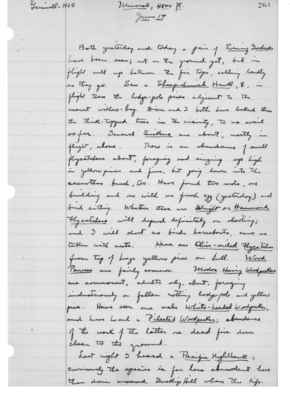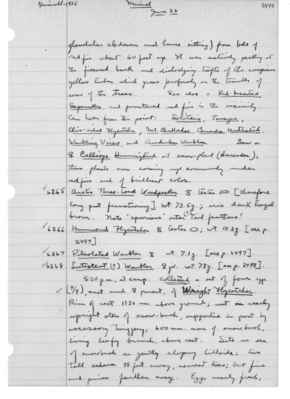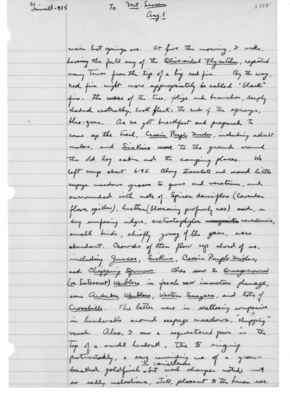Pages That Mention Olive-sided Flycatcher
1925: Joseph Grinnell's field notes
S2 Page 7
Collector: Grinnell - 1925 Location: Lassen Section (Mineral) Date: June 14, 1925 Page Number: 2463
Both yesterday and today a pair of Evening Grosbeaks have been seen; not on the ground yet, but in flight well up between the fir tops, calling loudly as they go. Saw a Sharp-shinned Hawk, female, in flight thru the lodge-pole pines adjacent to the nearest willow-bog. Dixon and I both have looked thru the thick-topped trees in the vicinity, to no avail so far. Several Siskins are about, mostly in flight, above. There is an abundance of small flycatchers about, foraging and singing up high in yellow pines and firs, but going down into the ceanothus bush, too. Have found two nests, one building and one with one fresh egg (yesterday) and bird sitting. Whether these are Wright or Hammond Flycatchers will depend definitely on shooting; and I will shoot no birds hereabouts, save any (?) taken with nests. Hear one Olive-sided Flycatcher from top of huge yellow pine on hill. Wood Pewees are fairly common. Modoc Hairy Woodpeckers are commonest, adults only, about, foraging industriously on fallen rotting lodge-pole and yellow pine. Have seen one male White-headed Woodpecker, and have heard a Pileated Woodpecker; abundance of the work of the latter on dead firs down clean to the ground. Last night I heard a Pacific Nighthawk; curiously this species is far less abundant here than down around Inskip Hill where the life-
S2 Page 39
Collector: Grinnell - 1925 Location: Mineral Date: June 23 Page Number: 2493
Mt. Chickadee (2); Western Tanager (5); Fox Sparrow (2); Chipping Sparrow (18); Hermit Warbler (3); Tolmie Warbler (1); Calaveras Warbler (1); Warbling Vireo (8); Calif. Purple Finch (4); Wood Pewee (13); Lazuli Bunting (3) Pileated Warbler (1); Spotted Sandpiper (2, along sparsely pebbled margins of creek); Traill Flycatcher (1); Yellow Warbler (2); Robin (29+, one seen carrying mud up to nest 50 feet above and on lowermost branch of huge yellow pine); Cassin Vireo (1); Audubon Warbler (7); Blue-fronted Jay (1); Turkey Vulture (2, one circling above vicinity of store (?), and one above woods at this end of the meadow) Brewer Blackbird (1, [female symbol] bathing and preening, as if just off nest); Pine Siskin (1); Ruby-crowned Kinglet (2); Canada Nuthatch (1); Crossbill (1, loud "chup" note heard from tips of yellow pine, given persistently, until bird flew, and also then); Killdeer (2); Meadowlark (2); Sierra Creeper (1); Western Bluebird (2); Western Lark Sparrow (1, [male symbol] singing volubly from well up in yellow pine at edge of meadow); Wright Flycatcher (2); Olive-sided Flycatcher (1); Solitaire (1); Pygmy Nuthatch (2, in different places, in upper parts of large yellow pines); White-headed Woodpecker (2); Modoc Hairy Woodpecker (2); Red-winged Blackbird (1+, heard from willows along stream, far out in meadows); Cassin Purple Finch (2, mating pair).
Total, for 1 1/2 hrs., 8:15-9:45: 38 species, 133 individuals.
1 p.m. Still at west end of Battle Creek Meadows. Have heard a Black-headed Grosbeak singing, and a Red-shafted Flicker. Just saw a Black-tailed Jack Rabbit (Lepus c. californicus) lope up the hill thru the snow bushes, from
S2 Page 45
Collector: Grinnell - 1925 Location: Mineral Date: June 26 Page Number: 2499
glandular abdomen and hence sitting) from bole of red fir about 60 feet up. It was actively pecking at the fissured bark and dislodging tufts of the conspicuous yellow lichen which grows profusely on the trunks of some of the trees. Saw also a Red-breasted Sapsucker, and punctured red fir in the vicinity. Can hear from this point: Solitaire, Tanager, Olive-sided Flycatcher, Mt. Chickadee, Canada Nuthatch, Warbling Vireo, and Audubon Warbler. Saw a [female symbol] Calliope Hummingbird at snow-plant (Sarcodes); these plants now coming up commonly under red firs and of brilliant colors.
6265 Arctic Three-toed Woodpecker [male symbol] testes [illustration] [therefore long past functioning] wt. 73.5g.; iris dark hazel brown. Note "spurious" outer ^(?) tail feathers!
6266 Hammond Flycatcher [male symbol] testes [illustration]; wt. 10.2g. [see p. 2497].
6267 Pileolated Warbler [male symbol] wt. 7.1g. [see p. 2497].
6268 Lutescent (?) Warbler [female symbol] jv. wt. 7.8g. [see p. 2498].
5:00p.m., at camp: collected a set of four eggs 4/4, nest and female parent, of Wright Flycatcher. Rim of nest 1130mm above ground; nest on nearly upright stem of snow-bush, supported in part by accessory twiggery; 600 mm. more of snow bush, living leafy branch, above nest. Site in sea of snowbush on gently sloping hillside; two tall cedars 75 feet away, nearest trees; but firs and pines farther away. Eggs nearly fresh;
S2 Page 88
Collector: Grinnell - 1925 Location: To Mt. Lassen Date: Aug. 1 Page Number: 2538 main hot springs are. At five this morning, I woke, hearing the full song of the Olive-sided Flycatcher, repeated many times from the tip of a big red fir. By the way, red firs might more appropriately be called "black" firs: the mass of the tree, folige [sic] and branches, deeply shaded centrally, look black, the ends of the sprays, blue-green. As we got breakfast and prepared to come up the trail, Cassia Purple Finches, including adult males and Siskins came to the ground around the old log cabin and the camping places. We left camp about 6:45. Along streamlets and around little seepage meadows grown to grass and veratrum, and surrounded with mats of Spirea densiflora (lavender flower spikes), heather (blossoming profusely now) and on dry surfacing ridges, arctostaphylos nevadensis, small birds, chiefly young of the year, were abundant. Crowds of them flew up ahead of us, including Juncos, Siskins, Cassia Purple Finches, and Chipping Sparrows. Also saw 2 Orange-crowned (or Lutescent) Warblers in fresh new immature plumage, some Audubon Warblers, Western Tanagers, and lots of Crossbills. The latter were in scattering companies in hemlocks around seepage meadows, "chupping"(?) much. Also, I saw a sequestered pair in the top of a small hemlock. The [male sign] singing protractedly, a song reminding me of a green backed goldfinch in variableness but much sharper noted; not so sadly melodious, still pleasant to the human ear.



